British and European Car Spotters Guide - 1958 |
|
|
 |
|
|
|
The encouraging sales trend of the previous year in the UK was continued to the extent that total car production in 1958 topped the million mark for the first time ever. This was, in no small part, due to the substantial increase in domestic car sales, brought about by the relaxation of credit control. UK registrations, in fact, accounted for 566,319 (including 4,986 hackneys) of the total car production of 1,055,337. The export total of 484,034-valued at over £187 million-was achieved despite a fall in demand in Asia and some of the Commonwealth countries. New models introduced during the year included the Allard GT, Austin A40 Farina, Austin-Healey Sprite, Bristol 406E, Riley One-Point-Five, Standard Ensign and Vauxhall Velox/Cresta. |
 |
 |
|
 |
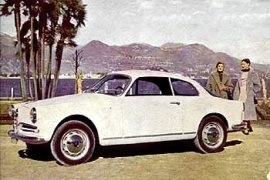 |
|
 |
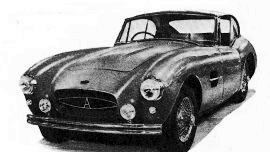 |
 |
Allard Gran Turismo Fixed-Head Coupe |
| |
Also see: Allard Car Reviews | The History of Allard |
| |
The Allard Gran Turismo Fixed-Head Coupe used the same chassis as the Palm Beach Mark II, except that it had a 20-gallon fuel tank. Introduced in October 1957, the new car featured streamlined two-door bodywork with the same general frontal appearance as the Palm Beach Mark II and air vents in the front wings. Standard power unit was the Jaguar 3-4 of 190 bhp, but larger and more powerful engines could be fitted, to customer's choice. Overdrive or automatic transsmission were optionally available. |
|
 |
 |
 |
Alvis 3-liter Model TC1 08/G Drophead Coupe |
| |
Also see: Alvis Car Reviews | The History of Alvis |
| |
The Alvis 3-liter Model TC1 08/G Drophead Coupe was similar to the 3-liter Saloon. This elegant version was also styled by Carrosserie Graber of Switzerland, who also built most of those models which were for export; those sold in Britain were made entirely in England. |
|
 |
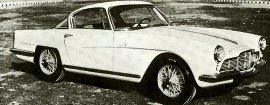 |
|
 |
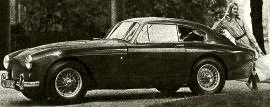 |
|
 |
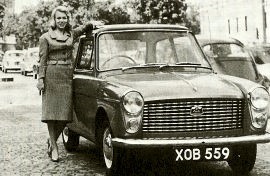 |
|
 |
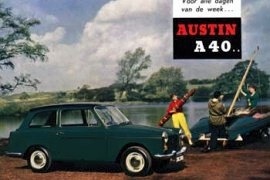 |
|
 |
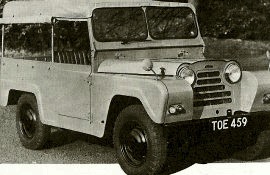 |
 |
Austin Gypsy |
| |
Also see: Austin Car Reviews | The History of Austin (AUS Edition) |
| |
The Austin Gypsy multi-purpose vehicle was developed during 1956-1957 and made its public debut in February of 1958. In addition to four-wheel drive it featured all-independent trailing arm suspension with Flexitor rubber springing Engine options were 2·2-liter four-cylinder petrol or diesel. with four-speed gearbox and two-speed auxiliary gear. |
|
 |
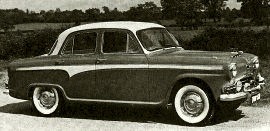 |
 |
Austin A 105 Vanden PIas Saloon Model BS8 |
| |
Also see: Austin Car Reviews | The History of Austin (AUS Edition) |
| |
The Austin A 105 Vanden PIas Saloon, Model BS8, was a luxury version of the standard A 105 and appeared in the spring of 1958. Overdrive was fitted as standard; automatic transmission was optional. The basic Model BS7 was continued without material changes. It was an Austin A 105 that won the 1957 British Mobilgas Economy Run, averaging 33·60 mpg over a difficult 1000-mile course. Both versions had a 102-bhp OHV Six engine. |
|
 |
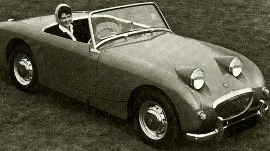 |
 |
|
| |
Also see: Austin Healey Car Reviews |
| |
The Austin-Healey Sprite, Model AN5, was a highly successful little sports car which became affectionately known as the 'Frogeye', in view of its prominent headlamps. Produced from March 1958 until April 1961, it featured a smooth-countered flush-sided two-seater body-the bonnet-cum-front wing assembly was hinged just forward of the windscreen-with an oval mesh radiator grille. The reliable BMC A-Series 948-cc power unit had twin carburetors and developed 43 bhp (net) at 5000 rpm. Wheelbase was 6 ft 8 in and the overall length 11 ft 5½ in, including front bumper. |
|
 |
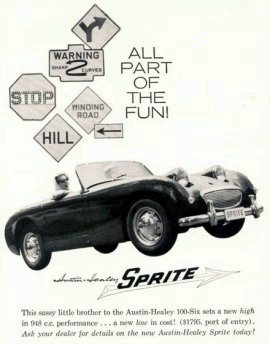 |
 |
|
| |
Also see: Austin Healey Car Reviews |
| |
The 'Frogeye' Sprite's friendly face, roadster style, affordable price tag and user-friendliness endeared it to drop-top enthusiasts. Not to put too stronger point on it, Austin themselves declard they were opening a new era in the sports car field, as not since 1938 had a small sports car been made by the Company. These early sports cars, ranging from the early "Ulsters" to the "Nippys" were all off-shoots of the 750cc racers, which had so many outstanding successes, holding many international and speed records and attaining speeds in excess of 100 m.p.h. Some of the original design points used on the pre-war Austin sports cars were used in a much more advanced and improved form on the Sprite. An example was the rear suspension which employed quarter-elliptic leaf springs and trailing arms. |
|
 |
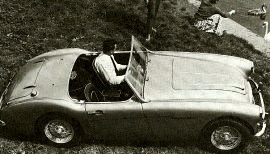 |
 |
|
| |
Also see: Austin Healey Car Reviews |
| |
The Austin-Healey 100 Six Sports two-seater, Model BN6, replaced the two/four-seater (BN4) version in the early part of 1958. The latter was, however, reintroduced later in the year (built by MG) and the two versions then ran concurrently until both were eventually superseded by the 3000 Model BN7. Compared with the two/four-seater the Model BN6 featured a larger boot and two 6-Volt batteries (instead of one 12-Volt unit), located at each side of the spare wheel, which was moved forward. |
|
 |
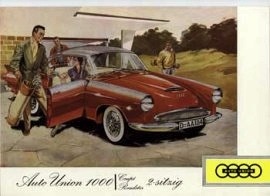 |
|
 |
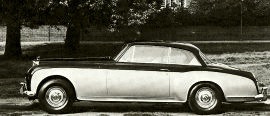 |
 |
Bentley Continental Flying Spur |
| |
Also see: Bentley Car Reviews | The History of Bentley |
| |
The Bentley Flying Spur was a six-light four-door sports saloon built by H. J. Mulliner on the Continental chassis, and was similar in appearance to the two-door Continental but had a step at the rear window, instead of the sweep of the tail line. Although both cars had the same overall height. the Flying Spur had more headroom for rear seat passengers and greater luggage space. |
|
 |
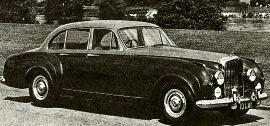 |
 |
Bentley Continental Flying Spur |
| |
Also see: Bentley Car Reviews | The History of Bentley |
| |
For 1958 the Bentley Continental chassis continued without material changes. Pictured left is an elegant two-door model with coachwork by Park Ward & Co. The rear seat could be hinged upwards; in conjunction with a concealed valance extension this gave additional luggage space. Air conditioning was introduced as an option on all Bentley cars. The engine was a 4887-cc six-cylinder with 8·0:1 compression ratio, good for a maximum speed of 120 mph. |
|
 |
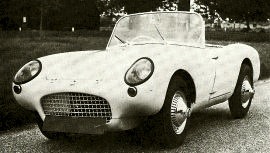 |
 |
Berkeley Sports |
| |
|
| |
The Berkeley range was extended in the autumn of 1957 by the introduction of a new three-cylinder two-stroke 492-cc triple-carburetor engine and a new hard-top coupe body style. The '492' had the same body as the '328' and featured a four-speed gearbox. The '328' Sports was continued with a number of modifications but only up until the spring when it was discontinued (it re-appeared in 1960 with a four-speed gearbox, but not for long). The '492' Sports and Drophead Coupe models were available to either a standard or de luxe specification. All had front-wheel drive. |
|
 |
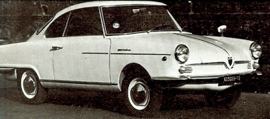 |
|
 |
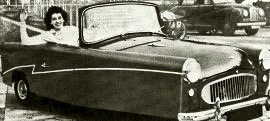 |
 |
Bond Minicar Mark E two-door open three-wheeler |
| |
Also see: Bond Car Reviews | The History of Bond Minicars (AUS Edition) |
| |
The Bond Minicar Mark E two-door open three-wheeler was distinnguishable from its predecessor-the Minicar Mark D De Luxe-by a new flat-sided body with straight-through wings and a wider oval radiator grille. It also featured a four-speed gearbox and a wrapround curved windscreen. The Villiers 197-cc single-cylinder two-stroke engine developed 9 bhp at 4000 rpm. |
|
 |
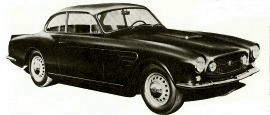 |
 |
Bristol 406E Saloon |
| |
Also see: Bristol Car Reviews |
| |
The Bristol 406E Saloon was an export-only model with bodywork by Gebr. Beutler of Switzerland. The car featured Bristol's new 2216-cc six-cylinder engine, which developed 105 bhp at 4700 rpm, and servooassisted disc brakes. Fog lamps were fitted at each end of the wide mesh radiator grille. Wheelbase was 9 ft 6 in and overall length 16ft. |
|
 |
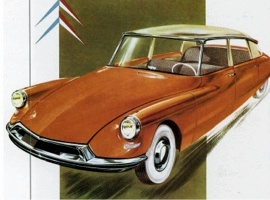 |
 |
Citroen ID19 Saloon |
| |
Also see: Citroen Car Reviews | The History of Citroen (AUS Edition) |
| |
The Citroen ID19 Saloon was a revolutionary front-wheel-drive model which was produced in France from late in 1956 and then also in England from early in 1958. This 'age-less' car featured a highly advanced hydro-pneumatic suspension system which kept the car at the same height and on an even keel whatever the load, camber or road surface, powered front-wheel disc brakes, a 1·9-liter four-cylinder engine and ultra-streamlined bodywork. The 1019 was a less-expensive version of the luxurious DS19, which had been introduced in France at the end of 1955. |
|
 |
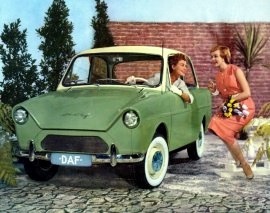 |
 |
DAF 600 |
| |
Also see: DAF Car Reviews | The History of DAF (AUS Edition) |
| |
The 600 was the first production car after the 1920s Clyno to have a continuously variable transmission (CVT) system - the innovative DAF Variomatic. The DAF Variomatic employed centrifugal weights to shift the transmission and was enhanced by an engine manifold vacuum. It was the only car ever produced which went faster by the simple expedient of gently and gradually releasing the accelerator once top speed had been reached. This increased manifold vacuum which helped the variable pulleys shift to an even higher ratio so even though the engine RPM stayed the same, the transmission increased the car's speed, in the case of the DAF 600, from 60 miles per hour (97 km/h) to nearly 70 mph (110 km/h) given enough time and level road. The Variomatic also permitted increased engine braking by operating a switch on the dashboard which reversed the action of the vacuum on the pulley's diaphragm, seeking a lower ratio with increased manifold vacuum. |
|
 |
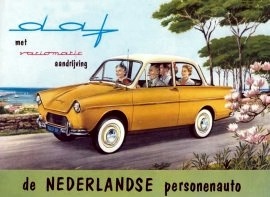 |
|
 |
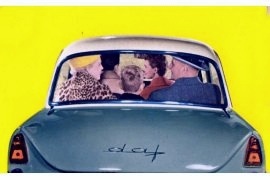 |
|
 |
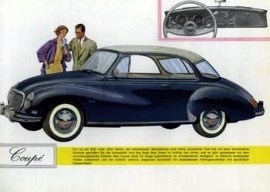 |
 |
DKW Coupe |
| |
|
| |
|
|
 |
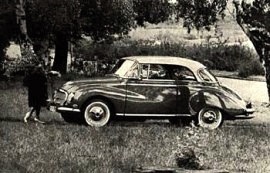 |
 |
DKW S Coupe |
| |
|
| |
|
|
 |
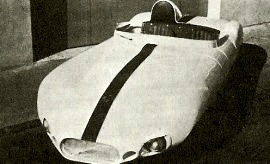 |
 |
Elva Mark III Sports |
| |
|
| |
The limited-production Elva Mark III Sports competition car was built by Elva Cars of Bexhill-on-Sea, Sussex and featured a Coventry Climax 1098-cc 84-bhp engine (1½-liter version also available), an MG gearbox and a low flat body mounted on a multi-tubular space frame. Also available was the Elva Courier, which was powered by a 1½-liter MG engine. |
|
 |
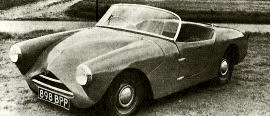 |
 |
Fairthorpe Electron Minor Convertible |
| |
|
| |
The Fairthorpe Electron Minor Convertible was a light plastic-bodied two-seater (occasional three-seater) powered by a Standard Ten 948-cc engine with a raised compression ratio of 8·25:1 Also available from this small Buckinghamshire firm were the Electron Sports (with Coventry Climax engine) and the Atomata (with BSA 646-cc Golden Flash engine). |
|
 |
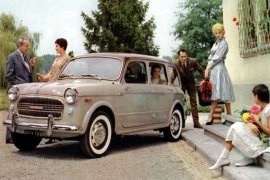 |
|
 |
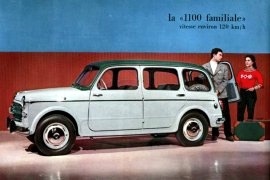 |
 |
Fiat 1100 Familiare |
| |
Also see: Fiat Car Reviews | The History of Fiat |
| |
Between 1956 and 1960 the Fiat 1100 underwent several slight changes in fittings and details, such as a newly designed grille, more rectangular profile, dual color two-tone paintwork, and eventually small fintails with spear-shaped tail-lights. |
|
 |
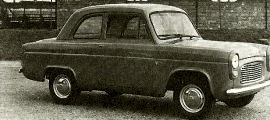 |
 |
Ford Anglia Saloon Model 100E |
| |
Also see: Ford UK Car Reviews | The History of Ford |
| |
The Ford Anglia Saloon Model 100E was continued with a number of changes which included a new mesh radiator grille, modified front lamp bezels, larger rear window and rear lamp assemblies, chromium bumpers, and a new facia layout. Newton-drive two-pedal control was optionally available for approximately one year. The Saloon De Luxe featured chrome strips on body sides, chrome window surrounds and other refinements. |
|
 |
 |
 |
Ford Escort Estate (Wagon) |
| |
Also see: Ford UK Car Reviews | The History of Ford |
| |
The Ford Escort Estate was derived from the Anglia 100E and continued with modifications similar to those made on the Anglia. The wood mouldings which previously distinguished the more luxurious Squire Estate Car were replaced by chrome strips. |
|
 |
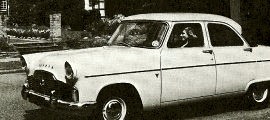 |
 |
Ford Zephyr Mark II Saloon Model 206E |
| |
Also see: Ford UK Car Reviews | The History of Ford |
| |
The Ford Zephyr Mark II Saloon, Model 206E, was continued with a number of modifications including a new grille of horizontal bars with rectangular combined side lights and flashing direction indicators. The luxurious Zodiac 206E continued with modified front lights - as on the Zephyr - and detail interior improvements. The Consul 204E range was extended by the addition of a De Luxe Saloon. Farnham Estate Cars were also available; these were conversions of the saloons. |
|
 |
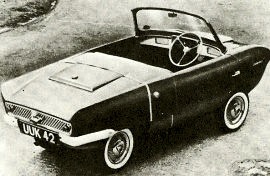 |
 |
Frisky Sport Convertible |
| |
|
| |
The Frisky Sport Convertible was a very small rear-engined four-wheeled two-seater, built by Henry Meadows (Vehicles) Ltd of Wolverhampton. It featured a Michelotti styled bodyywith a detachable tail-and a Villiers air-cooled 342-cc 16·5-bhp engine. A closed version was also made. In October a sports roadster was announced-the Frisky Sprint-but this model did not reach the production stage. |
|
 |
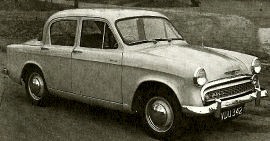 |
 |
Hillman Minx Series II Special Saloon |
| |
Also see: Hillman Car Reviews | The History of Hillman (AUS Edition) |
| |
The Hillman Minx Series II Special Saloon was distinguished from the Series I Special by a restyled mesh radiator grille, incorporating the sidelights and 'Hillman' in script. The engine was also modified. Other Minx models were the De Luxe ('Jubilee') Saloon, Convertible and Estate Car. Manumatic transmission was optional on all except the Special Saloon. |
|
 |
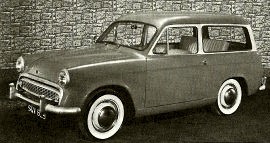 |
 |
Hillman Husky Series II Estate |
| |
Also see: Hillman Car Reviews | The History of Hillman (AUS Edition) |
| |
The Hillman Husky Series II Estate, which replaced the 1954-1957 Mark I, had similar features to the Series II Minx Special Saloon and was powered by the 1390-cc overhead-valve 51-bhp engine. Wheelbase was 7 ft 2 in, overall length 12 ft 5½ in. |
|
 |
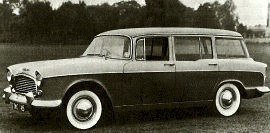 |
 |
Humber Hawk Estate |
| |
Also see: Hillman Car Reviews | The History of Hillman (AUS Edition) |
| |
The Humber Hawk Estate was based on the Hawk Series I Saloon. This spacious version had a load volume of 56 cu. ft with the rear seat folded down, and about half that capacity with the seat raised. The divided rear door comprised a top-hinged glazed upper half and a bottom-hinged tailgate. Mechanically, the only difference between the Saloon and Estate lay in the springing. |
|
 |
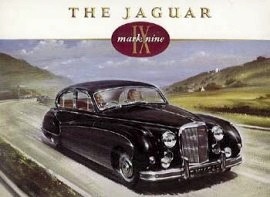 |
|
 |
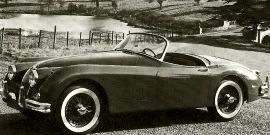 |
 |
|
| |
Also see: Jaguar Car Reviews | Jaguar - A Racing Pedigree | The History of Jaguar |
| |
The Jaguar XK150 Roadster was introduced in the spring of 1958. This open two-seater was available - initially for export only - with a choice of three 3½-liter engines: twin-carburetor 'standard', 190-bhp; twin-carburetor 'blue top', 210-bhp; and triple-carburetor 'gold-top' 252-bhp. When fitted with the 'gold top' engine it was called the XK150 Roadster Type S and featured other differences including a stronger clutch and special quick-changing pads for the servo-assisted disc brakes. The XK150 Roadster became available to the UK market in the autumn of 1958. |
|
 |
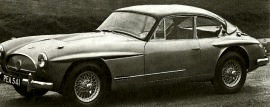 |
 |
Jensen 541 R Saloon |
| |
Also see: Jensen Car Reviews | The History of Jensen |
| |
The Jensen 541 R Saloon first appeared in October 1957, priced £1910 plus £956 PT. Differences from the standard and de luxe 541 versions included increased power from its Austin DS7 engine, a new slightly smaller gearbox with closer overall ratios, rack and pinion steering and disc brakes all round. Externally the R was distinguished by an outlet with plated grille in the bonnet top, torpedo-shaped mouldings above the rear wheels, and a top-hinged luggage boot lid. Top speed: over 125 mph; cruising: 90-100 mph. |
|
 |
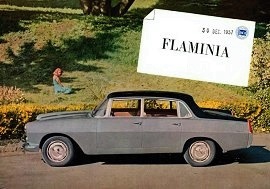 |
|
 |
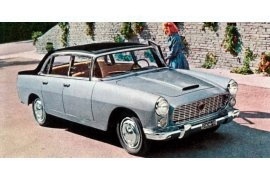 |
|
 |
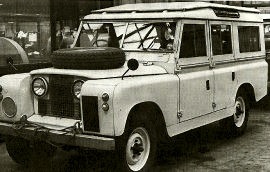 |
 |
Land-Rover 88 and 109 Series I |
| |
Also see: Land Rover Car Reviews | The History of Rover (AUS Edition) |
| |
The Land-Rover 88 and 109 Series I models were superseded early in 1958 by a new range, designated Series II. They were distinguishable by somewhat 'rounder' bodystyling with rocker panels below the doors. The 10-seater Station Wagon was continued on the earlier 107-in wheelbase Series I chassis until November. Its replacement the 109 Series II (shown here in military guise), followed shortly afterwards. The 1952-58 1997-cc petrol engine was replaced by a 2286-cc unit. A 2052-cc diesel engine was optional. |
|
 |
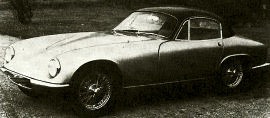 |
 |
Lotus Elite Coupe |
| |
Also see: Lotus Car Reviews | The History of Lotus | Colin Chapman (AUS Edition) |
| |
The Lotus Elite Coupe was a highly attractive Gran Turismo two-seater which heralded Colin Chapman's graduation from special sports/racing cars into true passenger-car production. The Elite featured a 1216cc 72-bhp Coventry-Climax engine, all-independent suspension, disc brakes all round, and resin-bonded fiberglass bodywork. |
|
 |
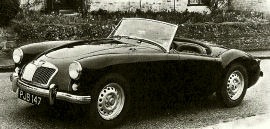 |
 |
|
| |
Also see: MG Car Reviews | The MG Story | The History of MG |
| |
The MG MGA Twin Cam open two-seater was externally similar to the MGA, apart from 'Twin Cam' motifs on the scuttle and boot lid, but was powered by a twin-overhead-camshaft 1588-cc engine achieved by enlarging the bore size to 75·4 mm - which had a 9·9:1 compression ratio and developed 108 bhp (gross) at 6700 rpm, and was fitted with disc brakes all round. Centre lock disc wheels were standard. Also available was a Coupe version. The 1489-cc MGA models were continued without material changes. |
|
 |
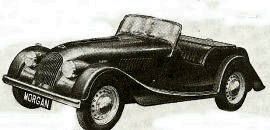 |
 |
Morgan Plus-Four |
| |
Also see: Morgan Car Reviews | The History of Morgan |
| |
The Morgan Plus-Four was continued with a number of new features which included a wider body - a total of 5 inches when measured across the seats-and a lowered radiator cowl, which resulted in a shorter grille. Wire wheels were optionally available. |
|
 |
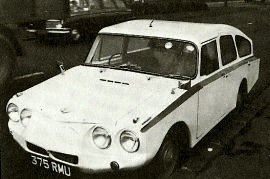 |
 |
Morris Minor |
| |
Also see: Morris Car Reviews and The History of Morris (AUS Edition) |
| |
A Morris Minor with a difference: a rather bizarre special-bodied version, snapped in the London SE area in the late sixties. It had a top-hinged glass-panelled tailgate allowing access to a rear-facing back seat. |
|
 |
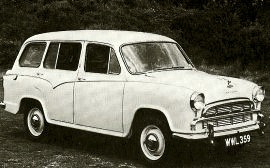 |
 |
Morris Oxford Traveller Series IV |
| |
Also see: Morris Car Reviews and The History of Morris (AUS Edition) |
| |
The Morris Oxford Traveller Series IV all-steel bodied four-door estate car replaced the 1956-57 Series III version in the summer of 1957. Duo-tone color schemes were optionally available. An unusual feature was the provision of two fuel filler caps, one on either side of the car, for the single 111 gallon tank. Half-ton Pickup and Van versions were also produced (1956-1960). |
|
 |
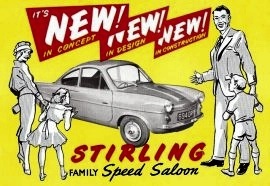 |
 |
Opperman Stirling Family Speed Saloon |
| |
|
| |
The Unicar was a 2-4 seater microcar constructed from fiberglass. It had a rear-mounted 2-stroke 2-cylinder engine of just 225cc or 328cc.The car was also available in kit form. This miniature GT model, called the Stirling, made its debut at the 1958 London Motor Show. Engine size had grown to 424cc. Very few were sold. |
|
 |
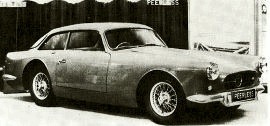 |
 |
Peerless Gran Turismo |
| |
|
| |
The Peerless Gran Turismo was a two-door sports saloon with fiberglass bodywork which Peerless Motors Ltd of Slough, Bucks, put into limited production in the spring of 1958. The 1991-cc 100-bhp engine and the gearbox were Triumph TR3 units, with overdrive fitted as standard. In June 1959 it was replaced by a modified (Phase 2) version. |
|
 |
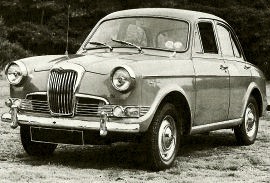 |
 |
Riley One-Point-Five 1½-liter Saloon |
| |
Also see: Riley Car Reviews | The History of Riley |
| |
The Riley One-Point-Five Saloon was powered by a lively 1½-liter twin-carburetor BMC B-Series engine which developed 68 bhp at 5400 rpm. It had the same body shell as the less powerful Wolseley 1500, but was distinguished by a traditional Riley grille and more elaborate brightwork. The typically Riley interior included a walnut facia-panel and comprehensive instrumentation. The car was competitively priced at £864. |
|
 |
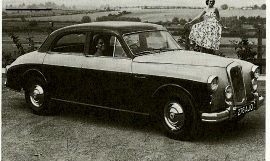 |
 |
Riley Two-Point-Six 2.6 Model UA Saloon |
| |
Also see: Riley Car Reviews | The History of Riley |
| |
The Riley Two-Point-Six Model UA Saloon was in production during 1957-1959. Although externally rather similar to the Pathfinder, which was discontinued early in 1957, it was distinguished by cowled headlamps, separate sidelamps and flashing direction indicators, a wider rear window, fog lamps mounted on the front overriders and two-tone paintwork. The six-cylinder 2639-cc engine developed 101 bhp at 4750 rpm, and the car was capable of speeds in excess of 100 mph. |
|
 |
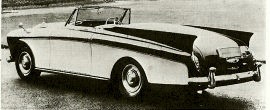 |
 |
RolIs-Royce Silver Cloud Convertible |
| |
Also see: Rolls-Royce Car Reviews | The History of Rolls-Royce |
| |
A RolIs- Royce Silver Cloud with rather unusual convertible coachwork by Freestone and Webb. The two-door body featured slightly concave sides, prominent rear tail fins and an enormous luggage compartment. |
|
 |
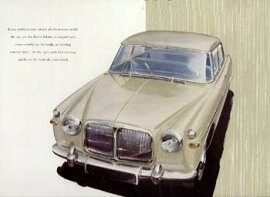 |
|
 |
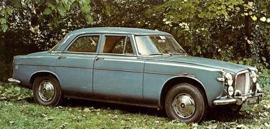 |
|
 |
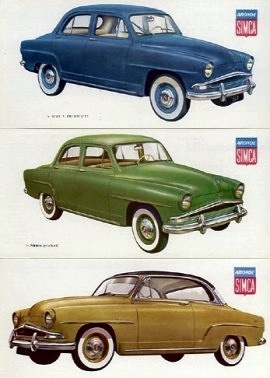 |
|
 |
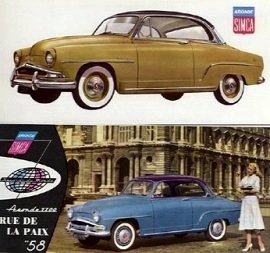 |
|
 |
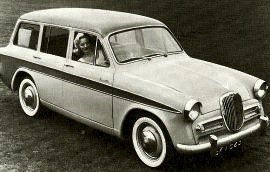 |
 |
Singer Gazelle Series II Estate |
| |
Also see: Singer Car Reviews | The History of Singer |
| |
The Singer Gazelle Series II Estate added to the Saloon and Convertible which were modified (became Series II) in the autumn of 1957. Changes included a different front end in which grilles with horizontal bar replaced the pressings on each side of the radiator grille, cowled headlamps and a bonnet motif. The capacity of the petrol tank was increased to 10 gallons and overdrive became optionally available. In the spring of 1958 a 1494-cc overhead-valve engine and recirculating ball type steering gear were introduced; the range then became known as the Series IIA. |
|
 |
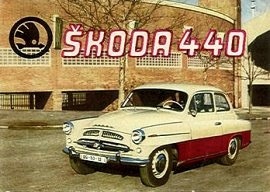 |
|
 |
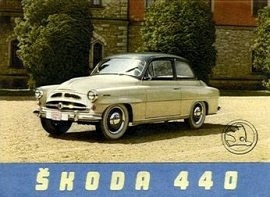 |
|
 |
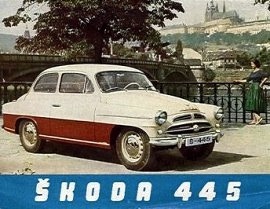 |
|
 |
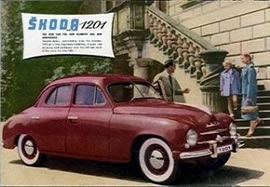 |
|
 |
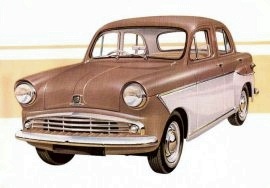 |
|
 |
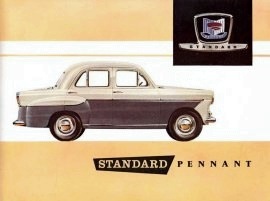 |
 |
Standard Pennant |
| |
Also see: Standard Car Reviews | The History of Standard |
| |
The Standard Pennant Saloon was a more expensive supplement to Standard's small car range. It appeared longer than the other models as a result of the extended front and rear wing lines. It also featured a larger rear window, a dual color scheme divided by a plated moulding strip and a new-style radiator grille. The 948-cc engine was retained, in modified form, and "Standrive" two-pedal transmission was optional. |
|
 |
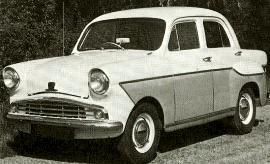 |
 |
Standard Pennant Saloon |
| |
Also see: Standard Car Reviews | The History of Standard |
| |
The Standard Pennant Saloon was a more expensive supplement to Standard's small car range. It appeared longer than the other models as a result of the extended front and rear wing lines. It also featured a larger rear window, a dual color scheme divided by a plated moulding strip and a new-style radiator grille. The 948-cc engine was retained, in modified form, and "Standrive" two-pedal transmission was optional. |
|
 |
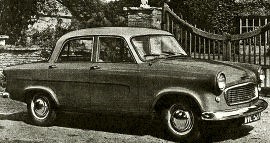 |
 |
Standard Ensign Saloon |
| |
Also see: Standard Car Reviews | The History of Standard |
| |
The Standard Ensign Saloon was a cheaper version of the Vanguard III and featured the same body shell albeit distinguished by a simple mesh grille. Mechanical differences included a slightly smaller enginee1670-cc capacity-and a four-speed gearbox with central floor change lever. |
|
 |
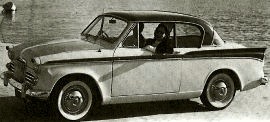 |
 |
Sunbeam Rapier Series II |
| |
Also see: Sunbeam Car Reviews | The History of Sunbeam |
| |
The Sunbeam Rapier Series II appeared early in the year and differed from the Series I by an completely changed front end and flared tail fins which merged with distinctive full-length bodyside flashes. Mechanical changes included the adoption of a 1494-cc 73-bhp engine, called the Rallymaster. A Convertible version was also offered. |
|
 |
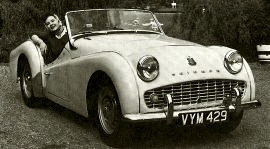 |
 |
Triumph TR3A Sports Roadster |
| |
Also see: Triumph Car Reviews | The History of Triumph |
| |
The Triumph TR3A Sports Roadster differed from the preceding TR3 by a new wide and shallow radiator grille, slightly recessed headlamps, overrider upper stay-bars and external lockable handles for doors and luggage boot. A hard-top coupe was also available. The TR3A had been available for export from August 1957 and in January 1958 replaced the TR3 on the home market. |
|
 |
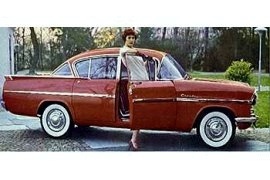 |
|
 |
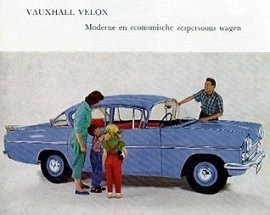 |
 |
Vauxhall Velox |
| |
Also see: Vauxhall Car Reviews |
| |
The Vauxhall Velox Saloon Model PAS was fitted with a completely new and attractive American-style body which it shared with the Cresta PAD version and which featured a full panoramic windscreen with a slope of 45 degrees, but with a slight curvature from top to bottom to reduce reflections, a three-piece rear window, miniature rear wing fins and slightly-cowled headlamps. The six-cylinder 2262-cc engine and the gearbox were modified versions of well-tried Vauxhall units. The Cresta, which was a more luxurious version of the Velox, had additional brightwork and fittings, and white-wall tires. |
|
 |
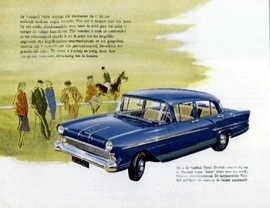 |
|
 |
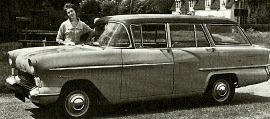 |
 |
Vauxhall Victor Estate Model FW |
| |
Also see: Vauxhall Car Reviews |
| |
The Vauxhall Victor Estate Model FW was introduced in March 1958. All Victors now had hooded headlamp rims and Newton drive two-pedal control was an optional extra. |
|
|
